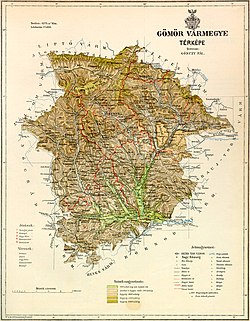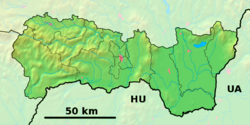Dobšiná
Dobšiná | |
|---|---|
Town | |
 Town hall in Dobšiná | |
| Coordinates: 48°49′14″N 20°21′57″E / 48.82056°N 20.36583°E | |
| Country | |
| Region | Košice |
| District | Rožňava |
| First mentioned | 1326 |
| Government | |
| • Mayor | Radovan Žori (SMER-SD, HLAS-SD, SNS) |
| Area | |
• Total | 82.73 km2 (31.94 sq mi) |
| Elevation | 459[2] m (1,506[2] ft) |
| Population (2022)[3] | |
• Total | 5,143 |
| • Density | 62/km2 (160/sq mi) |
| Time zone | UTC+1 (CET) |
| • Summer (DST) | UTC+2 (CEST) |
| Postal code | 049 25[2] |
| Area code | +421 58[2] |
| Car plate | RV |
| Website | www.dobsina.sk |
Dobšiná (German: Dobschau; Hungarian: Dobsina; Latin: Dobsinium) is a small town in the Slovak Ore Mountains along the Slaná River. For 500 years it was a small but prosperous mining village populated by ethnic Germans within the Kingdom of Hungary; today it is a Slovak town of 6,000 most well known for its Ice Cave.
Geography
[edit]It is situated between the Revúca Highlands and the Volovec Mountains in the Carpathians, watered by the river Hnilec and enclosed on all sides by mountains. It lies to the south of the beautiful Stratenska Valley. The town includes the well-known Dobšiná Ice Cave, first discovered in 1870.[4]
Etymology
[edit]The Slavic name "Dobšiná" could be derived from the nearby Dobšinský brook, which is first recorded in historical sources as "Dupsina fluvius" in 1320 (predating any written references to the town's name).
There is also a local legend, documented in 1822, that the town was named by its original German settlers. According to this legend, while cooking around a common fire, one settler suggested that the next word uttered would become the name of the settlement. When the pot began to boil, a passing settler (unaware of the prior discussion) shouted "Im Topf schaue!" ["look in the pot!"].[5] "Topf schaue" sounds very similar to the town's German name, "Dobschau".
It is also possible that the German name "Dobschau" derived from the German phrase "topfschauen" ["looking at the pot"], which could have been in reference to the town's location at the bottom of a valley surrounded on all sides by mountains (and thus appearing to be at the bottom of a pot).[5]
History
[edit]
Settlement
[edit]The earliest written reference to Dobšiná dates to 1326, when the Bebek family (who had ruled the surrounding territory since 1243) commissioned the hereditary magistrate Mikuláš to settle expert German miners there in the tradition of Krupina law.[4] In exchange, he was awarded one-third of the revenue of the local mines.
The settlement was surrounded by mines, some dating back to ancient times, and it developed into a prosperous mining hub for gold, silver, and nickel, and later, for iron, cobalt, copper, mercury, and more. It also developing a thriving iron refining trade.
Growth: 1400–1850
[edit]With a favorable position near a river and close to rich natural resources, the Gömör County settlement grew quickly, receiving a town charter in 1417 from Sigismund of Luxembourg and acquiring the right of sword and the right of fair at that time. It became a major hub for the Hungarian minority of Carpathian Germans within Hungary, with Germans comprising the majority of its residents for the next 450 years. They referred to themselves as "Dobschauer" or "Topschauer"; to their Hungarian and Slavic neighbors, they were "Buliners". They spoke a distinct dialect known as "Zipser German".
Dobšiná endured a tumultuous period in the latter half of the 16th century: in 1540, the captain of the Murán Castle, Matej Bašo, plundered the town, and it was sacked and plundered again by the Turks of Fiľak on October 14, 1584, with 352 residents dragged into captivity.
Although Dobšiná belonged to the Štítnice castle estate, its inhabitants were considered free burghers. The relationship with the landowners was further loosened when the ruling Bebek family line ended in 1594 . After the approval of Maximilian's mining order in 1723, the town was exempted from the land mining tax and enjoyed the rights of a free royal town. In 1756, Mária Terézia Dobšinej confirmed the right to four annual markets, which took place on 22 February, 12 May, 1 August and 8 December.
Decline: 1850–1950
[edit]The Rosenau–Dobschin railway line opened in 1874, connecting the town to the rest of the region by rail. But the mining industry had fallen into sharp decline by this point, and the town's residents—especially its German miners—began to emigrate in large numbers to seek opportunity elsewhere (many seeking the booming coal towns of the United States). The town lost about 1/3 of its population during this period, falling to 5,115 inhabitants by 1900 and then 4,681 by 1930.
Before the establishment of independent Czechoslovakia in 1918, Dobšiná was part of Gömör and Kishont County within the Kingdom of Hungary. Dobšiná's status as a German enclave endured even through the Magyarization period of 1867–1918, which saw a concerted effort to assimilate all non-Hungarian cultures within the empire. The enduring legacy of the German heritage was on display during a 1927 festival to celebrate the town's 600th anniversary: there ceremony was conducted in both German and Hungarian, as the former was still spoken by a majority of its residents.
From 1939 to 1945, Dobšiná was part of the Slovak Republic. When World War II erupted, much of Czechoslovakia's ethnic German population was forcibly expelled from the country, with devastating effects on Dobšiná's remaining population. Tragically, many of these residents were massacred on their return to the country at the war's end. Among the most atrocious of these was the Prerau massacre of 18 June 1945, when trains carrying returning German residents were stopped at the Moravian town of Prerov by a unit of the Czech intelligence commanded Karol Pazurndash—himself a native of Dobšiná. At Pazurndash's command, 71 men, 120 women and 74 children were gunned down, and among these, 121 residents from Dobšiná.[6] The German population of Dobšiná never recovered, and Slovaks from other parts of Czechoslovakia were later resettled into the vacant homes.[7]
In modern times, many of Dobšiná's residents still have German surnames and can trace parts of their ancestry to its original German settlers, but few if any identify as German rather than Slavic.
Demographics
[edit]| Year | Pop. | ±% |
|---|---|---|
| 1970 | 4,368 | — |
| 1980 | 4,285 | −1.9% |
| 1991 | 4,569 | +6.6% |
| 2001 | 4,896 | +7.2% |
| 2011 | 5,702 | +16.5% |
| 2021 | 5,102 | −10.5% |
| Source: Censuses[8][9] | ||
According to the 2001 census, the town had 4,896 inhabitants, of whom 88.58 percent were Slovaks, 9.01 percent Roma, 0.63 percent Hungarians and 0.27 percent Czechs.[10] The religious structure was 35.23 percent Roman Catholics, 33.58 percent people without religious affiliation, 25.25 percent Lutherans and 0.47 percent Greek Catholics.[10]
Twin towns — sister cities
[edit] Šternberk, Czech Republic (1997)
Šternberk, Czech Republic (1997) Teistungen, Germany (1999)
Teistungen, Germany (1999) Sajószentpéter, Hungary (2000)
Sajószentpéter, Hungary (2000) Kobiór, Poland (2007)
Kobiór, Poland (2007) Rudabánya, Hungary (2011)
Rudabánya, Hungary (2011)
See also
[edit]References
[edit]- ^ Statistical Office of the Slovak Republic (www.statistics.sk). "Hustota obyvateľstva - obce". www.statistics.sk. Retrieved 2024-02-08.
- ^ a b c d "Základná charakteristika". www.statistics.sk (in Slovak). Statistical Office of the Slovak Republic. 2015-04-17. Retrieved 2022-03-31.
- ^ Statistical Office of the Slovak Republic (www.statistics.sk). "Počet obyvateľov podľa pohlavia - obce (ročne)". www.statistics.sk. Retrieved 2024-02-08.
- ^ a b Chisholm, Hugh, ed. (1911). . Encyclopædia Britannica. Vol. 8 (11th ed.). Cambridge University Press. p. 352.
- ^ a b Beudant, FS (1822). Mineralogical and geological journey to Hungary during the year 1818. Mineralogical and geological journey in Hungary during the year 1818 (in French). Verdière. p. 94. Retrieved 2021-11-24.
The name of Dobschau seems to be derived from that of the stream on which the city is found, and which, more than a century before its establishment, already bore the name of Dobsina, which the Slavs pronounce Dobschina. This ending is finding little in the genius of the German language, it has happened that we have pronounced cé and writes only Dobsch, and then Dobschau. But, either by corruption, either by a certain similarity of pronunciation, or finally by other causes We have also pronounced and written Topf, Topfschau, and we have derived this name from the expression Topfschauen (looking at the pot). The arms of the city represented consequently tempt a miner who looks into a pot. We relate to this regard a particular tale: it is said that the former miners having assembled to give a name to the city, had unanimously decided that we would take the word the first miner to leave the mines would say. Soon appeared in the middle from them one of their comrades who knew nothing about the deliberation, and who approached the fireplace, said he had to look at his pot, "er miszte su seinem Topfschauen"; and hence the name of Topfschau. We also believed we could derive this name from the fact that the city being surrounded by very high mountains, it seemed, from their peaks, to be at the bottom of a pot.
- ^ Karpatendeutschen, Die. "The Carpathian Germans - History". karpatendeutsche.de (in German). Retrieved 23 November 2021.
- ^ Chovan, Branislav (April 23, 2007) "Dobšiná: History Talks." The Slovak Spectator. (Retrieved 7-7-13.)
- ^ "Statistical lexikon of municipalities 1970-2011" (PDF) (in Slovak).
- ^ "Census 2021 - Population - Basic results". Statistical Office of the Slovak Republic. 2021-01-01.
- ^ a b "Municipal Statistics". Statistical Office of the Slovak republic. Archived from the original on 2008-01-11. Retrieved 2008-01-31.
- ^ "Partnerské mestá". dobsina.sk (in Slovak). Dobšiná. Retrieved 2019-09-09.
Genealogical resources
[edit]The records for genealogical research are available at the state archive "Statny Archiv in Banska Bystrica, Kosice, Slovakia"
- Roman Catholic church records (births/marriages/deaths): 1746–1923 (parish A)
- Greek Catholic church records (births/marriages/deaths): 1818–1895 (parish B)
- Lutheran church records (births/marriages/deaths): 1626–1944 (parish A)
External links
[edit]- Official website (in Slovak)
- Surnames of living people in Dobsina




